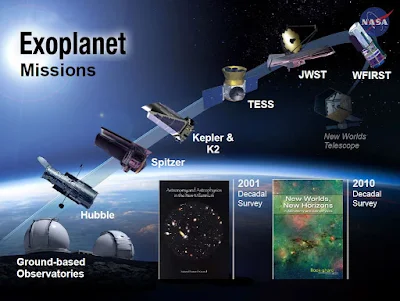Το
τηλεσκόπιο Kepler ανακάλυψε άλλους 1.284 εξωπλανήτες. Πολλοί από τους
εκατοντάδες νέους πλανήτες που ανακαλύφθηκαν είναι πιθανό να διαθέτουν φιλικές
στη ζωή συνθήκες. On May 10, 2016, NASA announced the discovery of 1,284
more alien planets by is Kepler Space Telescope, a haul that includes nine
exoplanets that might be habitable. This artist's concept depicts select
planetary discoveries made to date by NASA's Kepler space telescope. Credits:
NASA/W. Stenzel
Ερευνητές
του Πανεπιστημίου Πρίνστον και της NASA ανακοίνωσαν
την ανακάλυψη 1.284 εξωπλανητών!
Η
τεχνική
Kepler's candidates
require verification to determine if they are actual planets and not another
object, such as a small star, mimicking a planet. Credits: NASA Ames/W. Stenzel
Οι
ερευνητές χρησιμοποίησαν μια νέα τεχνική επιβεβαίωσης των σημάτων που έστειλε
τον Ιούλιο του 2015 το διαστημικό τηλεσκόπιο Kepler που εξερευνά τον γαλαξία μας για τον
εντοπισμό πλανητών. Οι ερευνητές παρουσιάζουν την ανακάλυψη τους στην
επιθεώρηση «The
Astrophysical Journal» και δηλώνουν βέβαιοι σε ποσοστό 99% ότι αυτοί οι
1.284 εξωπλανήτες είναι πραγματικά πλανήτες και όχι άλλα ουράνια σώματα.
A new statistical
validation technique enables researchers to quantify the probability that any
given candidate signal is in fact caused by a planet, without requiring any
follow-up observations. This technique uses two different kinds of
simulations-- both simulations of the detailed shapes of transit signals caused
by both planets and objects, such as a star, masquerading as planets (left
diagram), and also simulations of how common imposters are expected to be in
the Milky Way galaxy (right diagram). Combining these two different kinds of
information gives scientists a reliability score between zero and one for each
candidate. Candidates with reliability greater than 99 percent are call
“validated planets.” Credits: NASA Ames/W. Stenzel; Princeton University/T.
Morton
Το
Kepler, που εκτοξεύτηκε
το 2009, έχει εξετάσει εξονυχιστικά 150.000 άστρα για να βρει ενδείξεις
πλανητών σε τροχιά γύρω από αυτά και κυρίως πλανήτες που βρίσκονται σε απόσταση
τέτοια που θα μπορούσαν να έχουν νερό σε υγρή κατάσταση, κάτι που θα επέτρεπε
ενδεχομένως την εμφάνιση ζωής.
The histogram shows
the number of planet discoveries by year for more than the past two decades of
the exoplanet search. The blue bar shows previous non-Kepler planet
discoveries, the light blue bar shows previous Kepler planet discoveries, the
orange bar displays the 1,284 new validated planets. Credits: NASA Ames/W.
Stenzel; Princeton University/T. Morton
Το
Kepler υποδεικνύει μετά
από κάθε έρευνα του την ύπαρξη δεκάδων ή και εκατοντάδων πλανητών και στη
συνέχεια οι επιστήμονες προσπαθούν να επιβεβαιώσουν την ανακάλυψη. Μέχρι σήμερα
έχουν εντοπιστεί περίπου 5.000 «επίδοξοι» εξωπλανήτες και οι 2.325 από αυτούς
εντοπίστηκαν από το Kepler.
Kepler measures the
brightness of stars. The data will look like an EKG showing the heart beat.
Whenever a planet passes in front of its parent star as viewed from the
spacecraft, a tiny pulse or beat is produced. From the repeated beats we can
detect and verify the existence of Earth-size planets and learn about the orbit
and size of the planet. The scientific data from Kepler come in a different way
than most astronomy missions. The Kepler spacecraft will not produce pretty
pictures or even colorful spectrograms, but rather light curves derived from
brightness changes collected from transits. Credit: NASA Ames and Dana Berry
«Πριν από την εκτόξευση του Kepler δεν ξέραμε αν οι εξωπλανήτες είναι σπάνιοι
ή άφθονοι και τώρα φαίνεται ότι θα μπορούσαν να υπάρχουν περισσότεροι πλανήτες
παρά άστρα» αναφέρει ο Πολ
Χερτζ, διευθυντής του τμήματος αστροφυσικής της NASA. «Οι
πληροφορίες αυτές θα καθοδηγήσουν τις μελλοντικές αποστολές μας για να μάθουμε
αν είμαστε μόνοι ή όχι στο σύμπαν».
Η
ανακάλυψη
Since Kepler
launched in 2009, 21 planets less than twice the size of Earth have been
discovered in the habitable zones of their stars. The orange spheres represent
the nine newly validated planets announcement on May 10, 2016. The blue disks represent
the 12 previous known planets. These planets are plotted relative to the
temperature of their star and with respect to the amount of energy received
from their star in their orbit in Earth units. The sizes of the exoplanets
indicate the sizes relative to one another. The images of Earth, Venus and Mars
are placed on this diagram for reference. The light and dark green shaded
regions indicate the conservative and optimistic habitable zone. Credits: NASA
Ames/N. Batalha and W. Stenzel
Ανάμεσα
στους 1.284 πλανήτες υπάρχουν 550 βραχώδεις πλανήτες και εννέα βρίσκονται στη
λεγόμενη «κατοικήσιμη ζώνη». Είναι δηλαδή σε απόσταση τέτοια από το μητρικό
τους άστρο ώστε να είναι πιθανό να έχουν αναπτυχθεί σε αυτούς συνθήκες φιλικές
στη ζωή όπως για παράδειγμα, νερό σε υγρή μορφή.
The Arc of
Discovery artistic concept features NASA's astrophysics missions searching for
signs of life beyond Earth. Credits: NASA Ames/N. Batalha and W. Stenzel
«Η ανακάλυψη αυτή μας κάνει να ελπίζουμε ότι
κάπου, σε τροχιά γύρω από ένα άστρο παρόμοιο με τον Ήλιο μας, θα βρούμε τελικά
έναν αδελφό πλανήτη της Γης», δηλώνει η Έλέν Στόφαν, στέλεχος της NASA. «Οι
υπολογισμοί που κάνουμε μας δείχνουν ότι είναι πιθανό να υπάρχουν δεκάδες
δισεκατομμύρια κατοικήσιμοι πλανήτες. Προσωπικά πιστεύω ότι ένας τέτοιος
πλανήτης βρίσκεται σε κοντινή απόσταση, εκτιμώ σε απόσταση περίπου 11 ετών
φωτός από εμάς» αναφέρει η Ναταλί Μπατάλχα, στέλεχος της NASA και εκ των επικεφαλής της ερευνητικής
ομάδας.







Δεν υπάρχουν σχόλια:
Δημοσίευση σχολίου